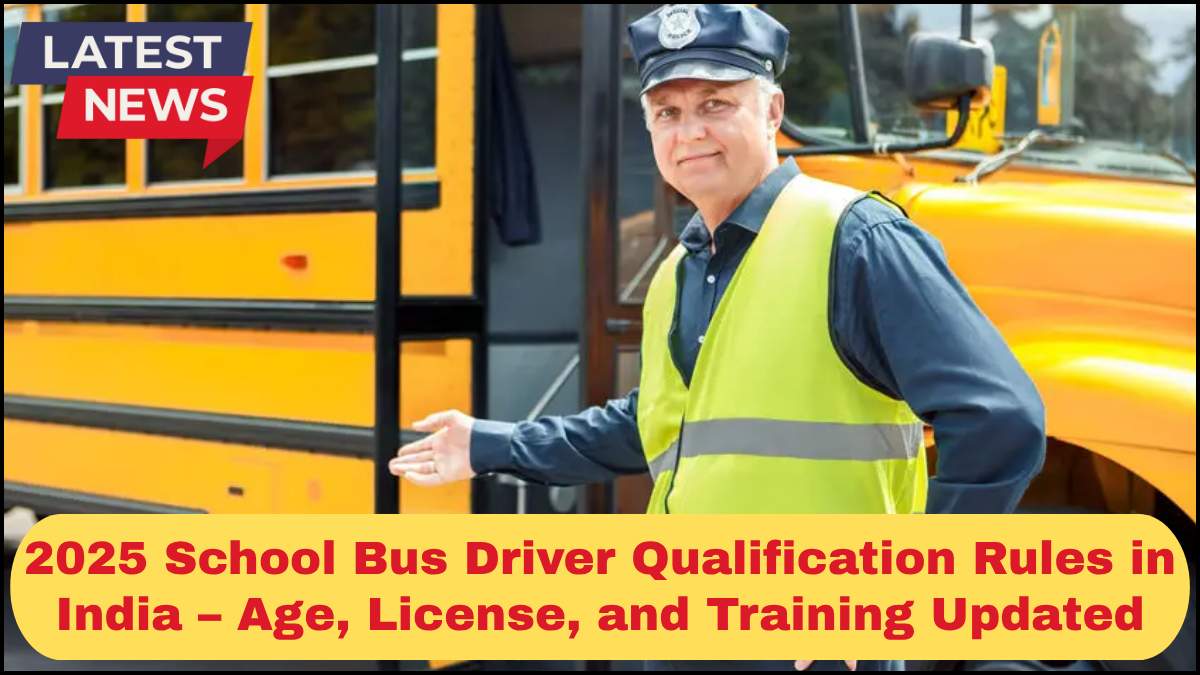The role of a school bus driver is more critical than ever, especially in a growing country like India where millions of children rely on safe transportation to and from school. To improve safety, accountability, and operational standards, the Indian government has revised the School Bus Driver Qualification rules in 2025. These updates cover age limits, licensing requirements, and structured training programs to ensure that only qualified and responsible individuals are entrusted with the job.

Here’s a comprehensive look at the new rules, what they mean for aspiring drivers, and how they impact schools and transport contractors alike.
Minimum and Maximum Age Requirements
One of the most notable changes in the 2025 update is the adjustment in age criteria for school bus drivers:
-
Minimum Age: 25 years
-
Maximum Age: 60 years
This range ensures that drivers have adequate life and road experience while also being physically fit to manage long hours and the responsibility of transporting children safely. Drivers above 60 can continue only if they pass mandatory medical fitness tests every year and receive clearance from a registered medical practitioner.
License Class and Endorsements
To be eligible, a driver must hold a valid Commercial Driving License (CDL) appropriate for the vehicle class. The following license classes apply:
-
LMV-TR (Light Motor Vehicle – Transport): For minibuses with seating under 20.
-
HMV (Heavy Motor Vehicle): For larger school buses that carry more than 20 passengers.
-
PSV Endorsement (Public Service Vehicle): This is mandatory and must be explicitly endorsed on the license for school transport eligibility.
The applicant must have held the appropriate license class for at least five years prior to being appointed as a school bus driver.
Mandatory Training Programs
As part of the 2025 reforms, all school bus drivers must complete an accredited driver training program designed for school transport. These training programs focus on:
-
Child Safety Protocols: Emergency evacuation drills, behavior management, and first aid.
-
Defensive Driving Techniques: Anticipating risks, managing blind spots, and following school zone rules.
-
Vehicle Maintenance Awareness: Daily safety checks and reporting mechanical issues.
-
Legal Compliance: Knowledge of Indian road safety laws, traffic signs, and penalties.
Training is conducted through government-certified driving schools or training centers partnered with educational boards or transport authorities. Certification must be renewed every three years.
Background Verification and Fitness
Beyond age, license, and training, the updated qualifications include:
-
Police Verification: A clean criminal record is non-negotiable. Drivers must submit clearance certificates from local police stations.
-
Medical Fitness: Annual physicals are required, covering eyesight, hearing, reflexes, and cardiovascular health.
-
Mental Health Screening: Psychological assessments are encouraged, particularly in urban centers, to ensure the driver is emotionally stable and capable of handling high-pressure situations calmly.
Experience and Local Knowledge
Prior experience in driving public transport or passenger vehicles is given strong preference. Additionally, familiarity with local routes, school timings, and traffic patterns is increasingly considered during hiring.
Schools and transport agencies now collaborate with local motor vehicle departments to verify experience records and driving history.
Technology Integration and Real-Time Monitoring
With digitization, many states have mandated GPS-enabled buses and driver monitoring systems. Drivers are expected to comply with:
-
GPS tracking for route monitoring
-
Speed governors to limit excessive driving speeds
-
Cameras and behavior monitoring for accountability
Understanding and cooperating with this technology is now part of the School Bus Driver Qualification process.
Enforcement and Penalties
Violating the new rules results in strict penalties. Schools hiring unqualified drivers may face:
-
Heavy fines under the Motor Vehicles Act
-
License suspension of the bus operator
-
Legal action in case of accidents due to negligence
Conclusion
The 2025 update to School Bus Driver Qualification rules in India marks a significant shift toward safety, professionalism, and accountability. By setting higher standards for licensing, training, and overall driver fitness, the government is prioritizing the well-being of students and peace of mind for parents.
For aspiring drivers, these updates mean more preparation and compliance—but also open doors to stable, respectable employment in school transport services.
Frequently Asked Questions (FAQs)
Q1. What is the minimum qualification for a school bus driver in India in 2025?
The driver must be at least 25 years old, hold a valid commercial driving license with PSV endorsement, and have completed certified school bus driver training.
Q2. What type of license is needed to drive a school bus?
Depending on the bus size, either an LMV-TR or HMV license is required, with a mandatory PSV endorsement.
Q3. Is experience required to become a school bus driver?
Yes. The driver should have at least five years of experience holding the relevant class of driving license.
Q4. Do school bus drivers need medical certification?
Absolutely. Annual medical check-ups are required to assess physical and mental fitness.
Q5. Who conducts the training programs?
Only government-authorized or partnered training centers can offer valid school bus driver training programs.
click here to learn more